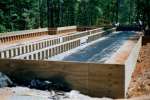Search engine visitors - click here to access entire "$ensible Home" web site
Click here to see a descriptive illustration of several permanent wood foundations.
Dear Jim: I am planning to build a house on a sloping lot. I thought about using an all weather wood foundation instead of concrete blocks or poured concrete. Will this be an energy efficient construction method? - Rich L.

A: You are lucky to find a sloped building site because it allows you to have the living space on the lower level partially sheltered by the ground. This allows you to take advantage of the nearly constant ground temperature and its protection without the problems of an underground home.
All weather wood foundations are called permanent wood foundations (PWF) today. PWF is an ideal foundation construction method for your sloped building site or for flat building sites. It produces one of the most energy efficient foundations and offers many advantages for your home.
A PWF is basically a standard insulated framed wall used for the foundation. It differs from a typical above-ground wall in that it uses pressure-treated lumber, is stronger and is designed to be water resistant.
PWF's have been used for decades and they hold up very well. Several companies produce complete PWF panels made to your building plans. Some of them offer overall 75-year and 15-year no-leak warranties. This is better than what you can expect from many concrete foundations. The poured concrete foundation at my house leaks every time it rains very hard.
The ease of insulating a PWF is a definite efficiency advantage if you plan to use that level for living area. When finished, that room will feel as warm and dry as any other room in your home. Batt insulation can be used in the deep wall cavity with additional rigid foam on the exterior if you wish.
A PWF can be built in any weather condition, so expensive construction delays due to bad weather are minimized. This is particularly true if you have the foundation walls premade by one of the PWF manufacturers. The subcontractors who build, install drywall, wiring, plumbing, etc. in the rest of the house can also do the PWF because the procedures are the same.
Before deciding for certain on a PWF, you should have a professional soil/site analysis done. Proper drainage is important for the PWF to function properly. With most soil types, adequate drainage tiles and other methods can be employed. There are some soil types and topography where a PWF may not be your best choice and poured concrete or blocks may be better.
While you are in the design phase of your home, you might consider an entire panelized home construction method. Some superinsulated panel house manufacturers also offer efficient PWF options. These are very high-quality, well-built houses (up to 3,000 sq. ft.) and you can do some of the assembly work yourself to lower costs.
Instant Download Update Bulletin No. 666 - listing manufacturers of complete permanent wood foundation (PWF) frame panels and other special construction materials, a soil conditions chart showing types of soils and their design properties, PWF design detail sketches and three floor plans and exteriors of several PWF/house kits.
Dear Jim: I live in an older house which has true masonry walls. There is only about a one-inch gap inside the walls. I was thinking about having foam insulation blown into the gap. Is this worthwhile? - Joe D.
A: Adding about one inch of foam insulation inside the walls would increase the total wall insulation by about R-4 to R-5 depending on the type of foam used and the quality of the installation job.
Your insulation contractor will have to do a payback analysis for you. The savings depend on many factors such as your furnace efficiency, local utility rates, average thermostat setting, wall construction, etc.